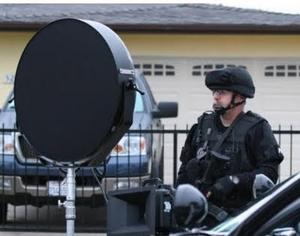Border securityMore border security means more business opportunities for tech companies
At last month’s Border Security Expo in Phoenix, both start-ups and established companies showed off their inventions in an effort to pitch projects to federal agencies. Two themes emerged in the show: the expo demonstrated that many of the systems and weapons systems that were used in the Iraq and Afghanistan wars are now becoming available to local, state, and federal law enforcement agencies – and companies expressed concern about the impact the federal budget cuts will have on their pockets.

One change over the years is the adaptation of military technology to policing applications // Source: jamnews.ir
At last month’s Border Security Expo at the Phoenix Convention Center in Arizona, Wyatt Nease held a remote which controlled a small car called the Pointman Tactical Robot (PTR). “Swat teams absolutely love it,” Nease, an unmanned systems specialist with Applied Research Associates, told the Guardian. “You can throw it through windows and doors, it goes up stairs, it’s self-righting. We can mount 12-gauge shotguns on it, so we can weaponize it as well.”
The Expo, which featured some 185 companies, gave both start-ups and established companies the chance to show off their inventions in an effort to pitch projects to federal agencies.
According to Nease, the PTR, which costs between $23,000 and $35,000, was originally only available to the military, but is currently being used by the FBI and LAPD for recon missions where it could be dangerous for humans to enter.
“You can send this robot up to a door, blast it and go right on through,” Nease told theGuardian. “You can add teargas canisters to it. If someone tries to come up to it you can detonate the teargas canister and haul ass out of there.” Other optional extras include strobe lights and shrieking noises to disorient suspects.
Other inventions shown off at the expo included the a license plate recognition system which would help police, but also ordinary businesses who want to catch people parking in unauthorized spaces; a video camera system that can be worn by law enforcement which can gather video and sound which could later be used in court; and ammunition rounds that flatten on impact in order to “obtain the proper amount of pain to enable target compliance.”
As much as these innovations can help law enforcement around the country and border security, exhibitors said they are concerned about the impact the federal budget cuts will have on their pockets. Several senior government officials who had been slated to give speeches canceled their appearances and stayed in Washington because of travel cutbacks. Law enforcement agencies around the country are cutting back and federal agencies have to cut their budgets as a result of the sequester.
“I’m curious to see what’ll happen with sequestration,” John McKinney, the director of Explora Security, which has offices in the United States, United Kingdom, and Jordan and has clients including NATO, the UN and the US military told the Guardian.
Exploria Security showed off a modular, mobile yet explosion-resistant tower that can be installed in just a few hours.
“When people learn your patterns they find ways to go round that,” McKinney told the Guardian. “As the border heats up, agents need something to protect them. It operates as a command center.”
In addition to inventions, the expo also demonstrated that many of the systems and weapons systems that were used in the Iraq and Afghanistan wars are now becoming available to local, state, and federal law enforcement agencies.
One example is the Physical Security Information Management (PSIM) software which gives law enforcement significant surveillance powers in urban or rural areas. PSIM makes it possible for several agencies to share information and make incident responses faster and more effective.
“Threats are always evolving. We’ve moved from a world where threats used to be single gunmen to a world where threats and risks are much more complicated.” John Gill, a former White House Chief Security Officer who now works for VidSys, a PSIM provider told the Guardian.
